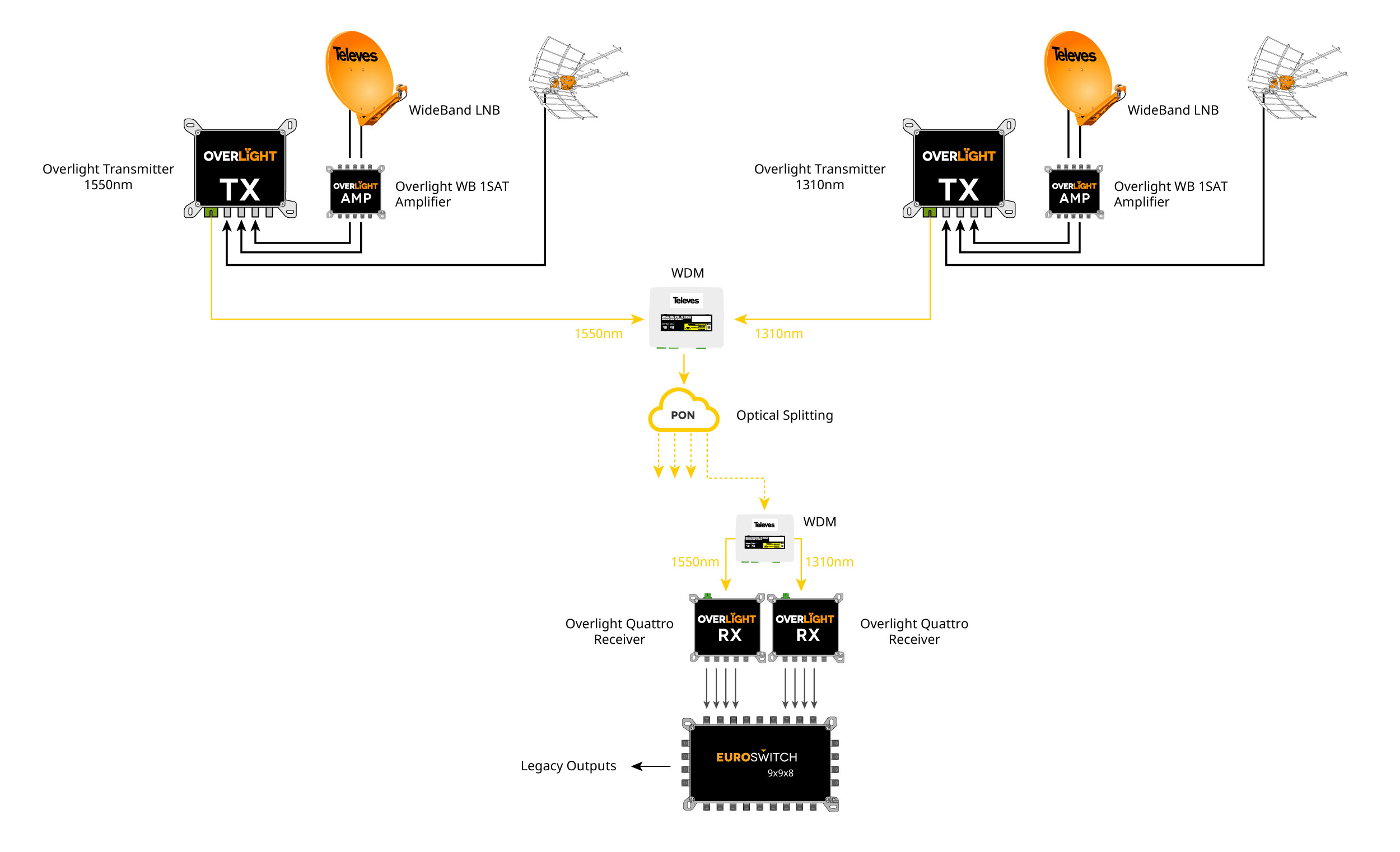Overlight WideBand Amplifier 29 dB, (1 satellite) 250...2400 MHz
Compact WideBand amplifier of the Overlight series for the distribution of satellite signals. This device amplifies the signal received from the LNB and is responsible for compensating the losses of the coaxial cable in the installation.
It can be powered from the Overlight transmitter or from an external power supply. Maximum gain up to 29 dB. It is equipped with 2 (H/V) WideBand inputs and 2 (H/V) WideBand outputs (250-2400 MHz). Indoor use.

- Independent gain and slope control
- Can be powered in the 12 V-to- 18 V range through its Jack connector or through the Overlight transmitter
- Very compact in dimensions and weight (137x120x30mm)
- 100% European design, quality, and manufacturing
- F-type RF connectors
- High-screening Zamak chassis
- Can be wall-mounted using screws
WideBand technology
WideBand (also known as FullBand) refers to broadband transmission technology that uses a wide range of frequencies. In WideBand TV systems, a substantial portion or the whole of the frequency spectrum is available to users. It can be used in fiber deployments where long cable runs are demanded, or coaxial scenarios in combination with multiswitches adapted to this technology.
In WideBand technology, an LNB captures a complete satellite signal and distributes it through 2 universal outputs (vertical -V- and horizontal -H-), each of them with the combination of high (H) and low (L) bands, in a frequency range between 290 and 2340 MHz.
Despite the fact that Quattro technology is the most widely deployed technology in TV systems nowadays, WideBand technology brings significant advantages to the installation:
- Simpler, faster and cleaner installation: In WideBand technology the number of coaxial cables connecting the LNB to the multiswitches is half as in traditional Quattro deployments, so the installation is done quicker and easier. The installation will also be tidier with fewer cables.
- Wider bandwidth than other technologies: WideBand channels can carry more information thanks to their wide bandwidth (290-2340MHz). This powerful feature allows a greater number of services to be delivered to the end users of the installation.
- Reusable deployment: WideBand technology allows signal distribution by reusing a Quattro installation. It can be distributed through the old 4 cables coming down from the roof to capture signals from up to 2 satellites, changing only LNBs and MSWs to be WideBand compatible.
| Number of inputs | 2 | ||
|---|---|---|---|
| Number of outputs | 2 | ||
| Bands |
| ||
| Frequency range | MHz |
| |
| Output level EN60728-3 IMD3 2tones -35dB | dBμV |
| |
| Gain | dB |
| |
| Gain adjustment range | dB | 0 ... 13 | |
| Slope regulation | dB | 0 ... 12 | |
| Isolation | dB | > 25 | |
| Powering | Vdc | 12 ... 18 | |
| DC pass through SAT line | mA | 500 | |
| Max current consumption (@12V) | mA | 150 | |
| Max current (@18V) | mA | 100 | |
| Max. power consumption | W | 1.8 | |
| Protection index (IP) | 20 |
Physical data
Net weight: 381 g
Gross weight: 445 g
Width: 137 mm
Height: 120 mm
Depth: 30 mm
Main product weight: 381 g
Packing
Box 1 Units
| tlv_discontinued | No | |||||||||||||||||||||||||||||||||||||||||||||||||
|---|---|---|---|---|---|---|---|---|---|---|---|---|---|---|---|---|---|---|---|---|---|---|---|---|---|---|---|---|---|---|---|---|---|---|---|---|---|---|---|---|---|---|---|---|---|---|---|---|---|---|
| tlv_tags | WideBand technologyWideBand (also known as FullBand) refers to broadband transmission technology that uses a wide range of frequencies. In WideBand TV systems, a substantial portion or the whole of the frequency spectrum is available to users. It can be used in fiber deployments where long cable runs are demanded, or coaxial scenarios in combination with multiswitches adapted to this technology. In WideBand technology, an LNB captures a complete satellite signal and distributes it through 2 universal outputs (vertical -V- and horizontal -H-), each of them with the combination of high (H) and low (L) bands, in a frequency range between 290 and 2340 MHz. Despite the fact that Quattro technology is the most widely deployed technology in TV systems nowadays, WideBand technology brings significant advantages to the installation:
|
|||||||||||||||||||||||||||||||||||||||||||||||||
| tlv_reflog | OLV-HG | |||||||||||||||||||||||||||||||||||||||||||||||||
| tlv_tabla_especificaciones |
|
|||||||||||||||||||||||||||||||||||||||||||||||||
| tlv_ean | 8424450271759 | |||||||||||||||||||||||||||||||||||||||||||||||||
| tlv_dim_product_x | 137 | |||||||||||||||||||||||||||||||||||||||||||||||||
| tlv_dim_product_x_label | Width | |||||||||||||||||||||||||||||||||||||||||||||||||
| tlv_dim_product_x_unit | mm | |||||||||||||||||||||||||||||||||||||||||||||||||
| tlv_dim_product_y | 120 | |||||||||||||||||||||||||||||||||||||||||||||||||
| tlv_dim_product_y_label | Height | |||||||||||||||||||||||||||||||||||||||||||||||||
| tlv_dim_product_y_unit | mm | |||||||||||||||||||||||||||||||||||||||||||||||||
| tlv_dim_product_z | 30 | |||||||||||||||||||||||||||||||||||||||||||||||||
| tlv_dim_product_z_label | Depth | |||||||||||||||||||||||||||||||||||||||||||||||||
| tlv_dim_product_z_unit | mm | |||||||||||||||||||||||||||||||||||||||||||||||||
| tlv_weight_product_label | Main product weight | |||||||||||||||||||||||||||||||||||||||||||||||||
| tlv_weight_product | 381 | |||||||||||||||||||||||||||||||||||||||||||||||||
| tlv_weight_product_unit | g | |||||||||||||||||||||||||||||||||||||||||||||||||
| tlv_gross_weight_label | Gross weight | |||||||||||||||||||||||||||||||||||||||||||||||||
| tlv_gross_weight | 445 | |||||||||||||||||||||||||||||||||||||||||||||||||
| tlv_gross_weight_unit | g | |||||||||||||||||||||||||||||||||||||||||||||||||
| tlv_net_weight_label | Net weight | |||||||||||||||||||||||||||||||||||||||||||||||||
| tlv_net_weight_unit | g | |||||||||||||||||||||||||||||||||||||||||||||||||
| tlv_net_weight | 381 | |||||||||||||||||||||||||||||||||||||||||||||||||
| tlv_1_type_pack | Box | |||||||||||||||||||||||||||||||||||||||||||||||||
| tlv_1_type_pcs_pack | Units | |||||||||||||||||||||||||||||||||||||||||||||||||
| tlv_1_pcs_pack | 1 |
-
Technical specifications
technical_specifications_en_US_TEC07220040_237562.pdf
(0.11 MB) -
User Manual
MUS06220002_001_ES-EN-FR-IT-DE-PL-RU-AR_237561_237562.pdf
(1.36 MB) -
Product release brochure
BRO_OVERLIGHT_EN-TUK_APRIL_2025_PLA07240013.pdf
(11.22 MB) -
Product release brochure
BRO_OVERLIGHT_EN-TME_APRIL_2025_PLA07240013.pdf
(11.24 MB) -
Product Sheet
237562_en_US_product_sheet_PSH01231323_237562.pdf
(0.11 MB) -
Declaration of Conformity
DOC09240006_0_237562.pdf
(0.22 MB)




